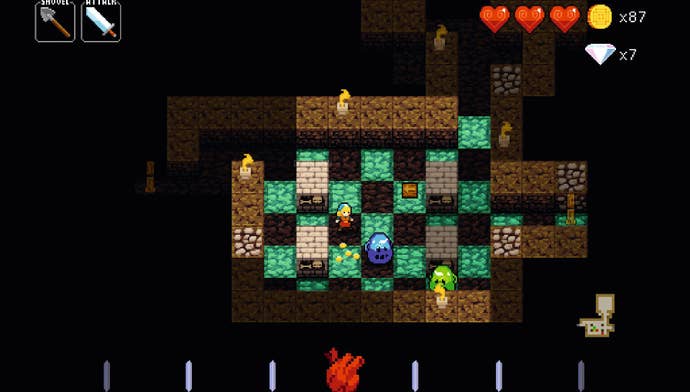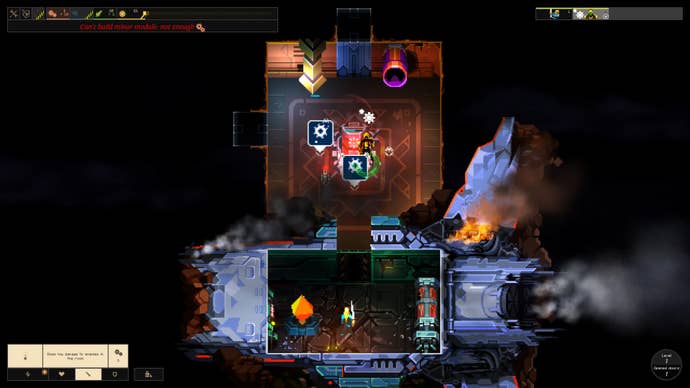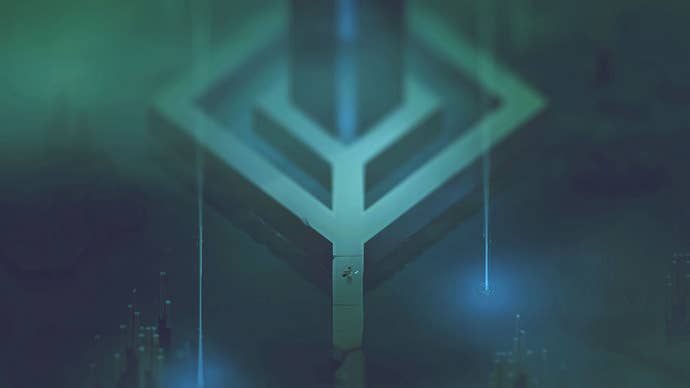Reinventing Genres, Not Just Pilfering Them
Indie games tend to gravitate toward similar play styles, but within that collective approach you'll find plenty of variety.
This article first appeared on USgamer, a partner publication of VG247. Some content, such as this article, has been migrated to VG247 for posterity after USgamer's closure - but it has not been edited or further vetted by the VG247 team.
A few months back, I talked to several independent game designers about the way they're collectively giving the Metroid style of exploratory platformer a degree of love that Metroid's creators, Nintendo, don't seem interested in expressing themselves. Sometimes (especially while walking around the PAX East show floor last weekend) I can't shake the impression that half the indie games currently in development fall into the "metroidvania" mold, while the other half comes in under the heading of roguelike.
And I'm certainly not complaining – those are two of my favorite styles of game. A lot of indie developers seem to share my tastes, and there but for the grace of god could I be producing some sort of Shiren/Metroid knockoff while struggling to pay rent. Freed from the shackles of publisher sales expectations, indies have the opportunity to dabble in genres that corporations find too niche to bother with... such as metroidvanias and roguelikes. So, naturally, that's what we're seeing independent developers produce. If publishers were allergic to first-person shooters, no doubt the indie scene would be inundated by those instead. Creativity, like nature, abhors a vacuum.
Perhaps the sudden explosion of these games over the past year or two would be cause for complaint if not for the incredible creativity that seems to come hand-in-hand with them. For every indie title I've seen that's simply content to iterate on familiar concepts, I can name two that take established genre standards and run with them. And even the iterative ones often shine with a level of low-fi polish that speaks of their creators' enthusiasm; Discord's Chasm more or less plays the Symphony of the Night/Ys III exploratory side-scroller concept straight, but it controls well and features thoughtful level design and some intricate systems beneath the surface.

Still, if every metroidvania or roguelike in the works took the same conservative approach as Chasm, the indie scene would be in for a brief, congested life. That's not the case, though. Chasm is more of a baseline work – it explores the inflection point from which so many other works on the same genre have branched off to do their own thing. For example, two Indie Megabooth aisles over from Chasm I found Gamesbymo's A.N.N.E., another pixel-art-based free-roaming platform that nevertheless plays totally unlike Chasm. It supplements the running and jumping with shooting – and not just with the character's handheld weapon. At any point, you can return to the hero's (or heroine's) fighter craft and take flight, traversing the game world at a totally different scale than the on-foot action plays out. Between areas of the game, you fight through side-scrolling shoot-em-up stages. A.N.N.E. clearly takes its cues from 8-bit classics Blaster Master and The Guardian Legend, but the synthesis of these elements ends up someplace completely new.
Likewise, NextGen Pants' Tetropolis may have come into being as the result of a goofy pun ("tetroidvania"), but from that dopey joke a fascinating and highly original game has sprung. Yes, it's a free-roaming 2D platformer, but it's no mere Metroid wannabe. It plays the Tetris concept to the hilt, with a tetromino for a protagonist; the little puzzle piece begins as a two-by-two square, but over the course of the adventure you gradually unlock the ability to morph into all the different tetromino shapes: An I-block, a T-block, a Z-block, and an L-block. (Reverse L and Z shapes aren't included, the designer says, because they'd be redundant mechanically.)
Each of the protagonist's different shapes offers a unique set of skills; for example, the I-block form can launch itself in any direction. You can also combine the different skills you uncover as well, as time slows while you choose a new shape, giving you the freedom to rearrange your piece in midair as a means of solving puzzles, reaching new areas, or bypassing deadly foes.

The Tetris mechanics don't stop there, though. Certain rooms in each dungeon allow you to literally play Tetris with the game map, breaking sets of rooms (predefined by different tetromino shapes) apart from the rest, moving them around, and rotating them. It's a clever play on the genre tenets laid down in Super Metroid and Symphony of the Night: The world overview maps in those games appeared as a grid of interconnected squares, and Symphony famously featured an entire unlockable second castle that forced you to battle through the first castle flipped upside down. Here, you simply break chunks of the map grid away from the rest and align their connection points to create new platforming challenges, unlock new areas, and solve otherwise impossible puzzles. The end result is quite an elaborate riff on what should have been a throwaway joke scribbled drunkenly on a napkin somewhere – a vindication of dad humor everywhere, and also a pretty cool-looking game.
It's the roguelike side of things that has truly seen the most inspired works, though. Ever since Derek Yu's rogue-inspired platformer Spelunky (and, I suppose, Dark Souls) awakened gamers to their primal desire to be humbled by frequent death and crushing difficulty, suddenly a genre that had traditionally only every earned the scorn and contempt of console RPG fans exploded into popularity. The thing is, though, those gamers still don't like traditional roguelikes; they continue to regard Nethack, Angband, and even faithful-yet-accessible console-based variants like Shiren the Wanderer as if they were freakish alien creations beneath their dignity to explore.
Instead, what we've seen has been a new wave of games that take a buffet approach to the tenets of roguelikes. The genre revolves around certain fundamental precepts, such as procedurally generated dungeons, permanent character death, the scarcity and impermanence of inventory items, and global turn-based actions centered on the player's movements. The creators of games like Spelunky and FTL looked at those rules, liked a few of them, and cherry-picked their favorites to incorporate into other genres or formats. Spelunky owes as much to Tim Martin's classic platformer Spelunker as it does to Nethack, and FTL integrates a real-time strategy element to take on as much of StarCraft's personality as, say, Dwarf Fortress'.
While these new children of Rogue are often barely recognizable as such, they take the essential components that make the roguelike so addictive to fans of the format and recast them intelligently in new shapes. For instance, Brace Yourself's Crypt of the Necrodancer magnificently turns the roguelike into a rhythm game, even offering support for DDR-style dance pads. It seems like a ridiculous concept, sure, but the kinetic graphics (everything in the dungeon bops to an infectious beat) and the fundamental simplicity of roguelike controls make for a weirdly compelling combination.

Meanwhile, Amplitude's Dungeon of the Endless takes the FTL-style strategy approach to its logical conclusion, stripping it down to something akin to a tower defense game. Players travel through randomized rooms, investing their earned attributes to activate power nodes and set up turrets as they advance. Once the exit becomes visible, your team of heroes has to lug a power crystal from the central reactor of your crashed ship to the escape hatch, moving on to the next floor. Meanwhile, swarms of space bugs attack, forcing you to make use of your characters' unique traits and ability to navigate the underground independently of one another.
And at the less manic end of the spectrum, Capybara's Below revels more in atmosphere than sheer challenge – though certainly it isn't shy about killing players as it deems fit. Predetermined (and terribly mysterious) set pieces dot the game world, connected by a number of random dungeons that change each time you set foot into them. Despite its evocative ambiance, which calls to mind Ico or Shadow of Colossus, Below wasted no time in killing me during my play session at PAX East: I wandered around the surface of the island on which the action is set for a few minutes, stumbled across a dungeon, and fell victim to a spike trap that instantly killed me within 30 seconds.
Failure in Below isn't game over, though. Your fallen hero is soon joined by a successor, who forges into the dungeon to retrace their steps. Permanent changes remain consistent, while dynamic elements – like dungeon layouts – completely shift from the previous session. Only the relative position of your fallen predecessor (and the now-spent hazard that felled him) remains the same, and you can loot the corpse for goods... ostensibly like gathering souls in Dark Souls, but equally referential to the roguelike "bones files" that inspired Dark Souls in the first place.

Combat happens infrequently enough in Below (or at least in the half-hour I've played of it) that it feels more like punctuation than the entire point of the game. Fending off dungeon beasts goes hand-in-hand with a number of interesting mechanics, such as bleeding. Capybara describes your character's health situation as "1 HP plus," meaning that you're always a single hit away from death; once you're wounded by even a small bite or nick, you'll eventually bleed out. To prevent that from happening, you need to make use of the game's gathering and crafting systems to create items that can staunch the blood flow and restore your lost health.
Of course, Below retains plenty of roguelike conventions: All the items you gather, from weapons to craftable goods, appear few and far between. You may occasionally stumble across something helpful, like a bow and arrow, but the arrows will be limited and your limited inventory space will force you forego carrying some other valuable tool. The visuals add to the tension, using a sort of shallow depth of field effect and limited illumination to create a fog of war that falls away as you press ever further into the gorgeous, hand-painted caverns.
The only thing all of these games have in common is an admirable refusal to simply plod along within the prescribed rules of the genres they're exploring. While independently developed projects may seem to fall neatly into easy categories, a closer look will reveal the error of such assumptions. After years of lurking at the edge of gaming's acceptable play styles, it's great to see these genres find new life and new potential in the hands of passionate developers.
